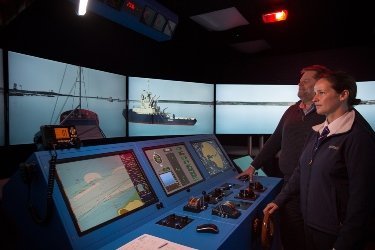As featured in the Port's newsletter, OnBoard, December 2016.
 A new, state of the art simulator that allows mariners to take the helm of any ship and navigate the Milford Haven Waterway was opened last Autumn in Milford Haven.
A new, state of the art simulator that allows mariners to take the helm of any ship and navigate the Milford Haven Waterway was opened last Autumn in Milford Haven.
Based in the Old Sail Loft at Milford Marina, the Port of Milford Haven Navigation Simulator Suite is the most capable and advanced simulator of its kind in the UK. Mariners can step onto a virtual reality bridge and work with other ships within a computer generated realm. With the right software it can also replicate any other port in the world.
Run by high powered computers, its graphics are incredible. But what might be an amazing looking simulator to the untrained eye has also hugely impressed mariners who’ve had a chance to try it out.
“It is sometimes hard to explain to people how many factors affect a ship in the Haven,” explained Steve Hardcastle, Deputy Harbour Master and the man charged with managing the Navigation Suite. “Wind, tides, visibility, depth are all obvious forces at work. However, this simulator can throw much more at its users. Interaction, how a ship behaves when it’s passing other vessels or moves close to land or objects in the water, is a mysterious but important consideration for anyone with the conduct of a vessel or on the helm. This system can accurately reproduce the effects of interaction. For example, when a large ship passes another smaller vessel it can actually pull that vessel towards it,” he explained. This is particularly important where large oil or LNG carriers work with tugboats or pilot boats in a busy port.
Tugboats play a vital role moving the ships in the waterway and helping them onto berths. This simulator allows tugboat masters to practice their craft on a separate simulator bridge whilst tethered to a ship being simulated on the main bridge.
“We can create a very realistic situation here,” continued Steve. “In the same building we have a fully operational control room, just like the one we have at Port Control (VTS) so we can put staff in there and run any kind of scenario we like, including emergency scenarios, and see how personnel respond. The ‘virtual’ ships will even appear on the VTS radar screens.”
The new suite, built by Dutch research company Marin, represents another major investment in technology to improve safety of shipping on the waterway. The Port has already helped develop a highly accurate mapping tool now used around the world (Safe Pilot) to enable pilots to more safely move and berth ships in any visibility.


